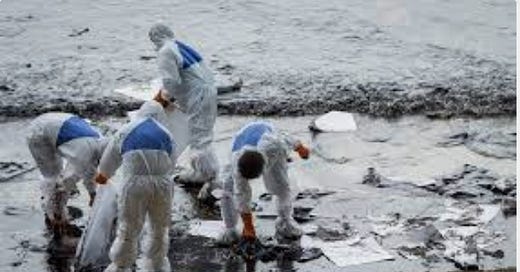This morning I had a recollection of reading a New York Times report on the BP Deepwater Horizon oil spill in the Gulf of Mexico. Like most industrial disasters, it was entirely predictable and preventable. BP was cited by OSHA in 2009 for 700 safety violations and for failing to to correct safety hazards revealed by the 2005 Texas City Refinery explosion.
Days before the April 20, 2010 Deepwater Horizon blowout, company engineers and managers knew the Deepwater Horizon was “bucking” from gas pressure. They simply chose to ignore the risk because the project was way over-budget.
BP has a long tradition of trying to cloak its rapacity with humbug virtue-signaling gestures such as its green sunflower logo. The state governments of Texas and Louisiana, as well as the U.S. federal government, knew the company’s reputation for putting profits way above the safety of its workers and the environment.
Having studied the 2005 Texas City Refinery explosion, I knew about it, and the New York Times report about the 2010 blowout was a reminder that a leopard never changes its spots. However, what really caught my eye as I browsed the paper was a full-page advertisement touting the federal response to the disaster.
With great pride, the National Oceanic and Atmospheric Administration (NOAA) proclaimed that its SCAT program was doing a yeoman’s job of cleaning up the Gulf Coast. As the advertisement explained, SCAT stands for Shoreline Cleanup and Assessment Technique.
This Technique involves a high-tech “methodology” for mopping up the oil, as was evidenced by a grainy photograph of men using what appeared to be gigantic paper towels on a beach.
I suppose it’s possible that NOAA’s vaunted SCAT Program did some great work. It was the program’s name that caused me to feel alarm about the education and judgement of its creators.
This morning I just heard from a witness here on Maui that the EPA and FEMA have some BIG projects in the works for Lahaina. VERY BIG projects. It will be interesting to see how these projects are communicated to the public. I’m thinking Cleanup Revitalization Assessment Program (CRAP) would be a good name for phase one.
One thing that is already fairly clear: FEMA cleanup contractors are going to have some very lucrative contracts for years to come.






I remember the BP disaster. The laborers on the beach with paper towels was only for the photo-ops. The real operation was spraying millions of gallons of toxic chemicals onto the oil slicks in the water, to get the oil to mix with the water and not float on top where people could see it. They intentionally doubled the toxic disaster to get it out of sight.
https://www.nola.com/news/environment/chemicals-used-to-fight-bp-spill-were-ineffective-and-toxic-study-says/article_80161caf-380b-5db9-a5ae-a3c2584fcf60.html
As bad as Big Oil is, I can’t help wondering if Big Batteries is any better? Lithium and cobalt vs methane and oil.